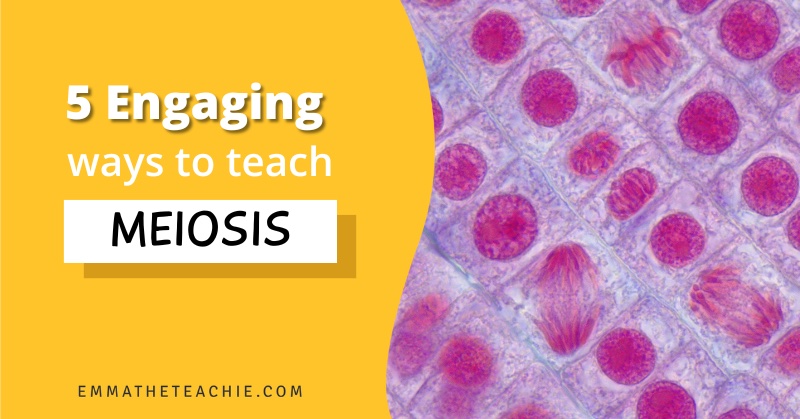
How to Teach Pedigree Charts – Lesson Activities
Two words – pedigree charts.
*insert chef’s kiss*
This is easily my favorite part of biology and the bread and butter to my genetics unit. I just find them so interesting.
While it is one of my favorite lessons, I have students who find these diagrams difficult to read and interpret.
However, if this topic is scaffolded and taught sequentially, students will find this topic to be engaging and accessible!
Let’s begin our journey into how to teach pedigree charts.

1 – Let Students Self-Explore Pedigree Charts
First, figure out what your students know (or don’t know).
It’s simple – give your students the independence to see what they can figure out about pedigrees on their own.
To do this, give them a pedigree chart without a key and tell them this is a chart that shows the inheritance of a genetic trait.
Instruct students to focus on the structure of the charts, identifying the relationships between individuals, and the symbols that are used. Ask them to write down what each part of it could be showing.
Then, what I’ll do is collect these answers to keep. Later on in the unit, I give it back to students and they can correct their own work.
Talk about an opportunity for self-reflection and working on written constructive feedback.
*wink wink*
By doing this, students will have a general idea of the structure of a pedigree chart, as well as sparking their curiosity and critical thinking skills.

2 – Take Notes of Pedigrees
Following the independent exploration of pedigree charts, guide students on taking notes about this topic.
You should present the different parts of pedigrees and explain what each part is and its significance.
Depending on your students, there are multiple ways to facilitate note-taking. Notes can be scaffolded with fill-in-the-blanks to ensure they get all of the vital information, or you can give them a blank pedigree to fully make their own.
A way to do all of this is through Doodle Notes.
If you are new to Doodle Notes, hop on over to “4 Reasons You Need to Use Doodle Notes in Your Biology Lessons” to see why I love them so much!
I have created a set of Doodle Notes about pedigree charts. This set of Doodle Notes includes open response and scaffolded versions, which are perfect for differentiation among students.
No matter the format you use, be sure to emphasize the significance of accurate labeling and the benefits of including examples and explanations.

3 – Build Pedigrees
After you have completed notes on the topic, let students build their own pedigrees.
This will help them get very familiar with the symbols.
For this type of activity, I like to use Google Slides where students can drag and drop the symbols into place with ease. I have found that this same activity done on pencil and paper can take AGES as some students will want to draw perfect circles/squares.
You can provide students with hypothetical genetic scenarios or real-life case studies and ask students to create pedigrees based on that information.
By incorporating this type of hands-on activity, you are allowing students to apply their knowledge, practice identifying patterns, and develop analytical skills.
All good things. All good things.
As students are working, be sure to provide feedback and facilitate discussions as students are working since this is still new. If you notice misconceptions, they must be clarified early on to prevent confusion later on in the unit.

4 – Practice, Practice, Practice
I don’t know about you, but I have heard that you need to practice something in order to excel at it.
In my opinion, pedigrees are not any different.
You need to provide students with a lot of practice problems. As students work through beginner level problems, the problems can go more and more in depth, linking their knowledge of Mendelian inheritance and Punnett Squares to the pedigree charts.
Once again, I suggest Google Slides due to time constraints. For instance, my interactive Google Slides activities have seven pedigree problems, and these get progressively more challenging.
As you create or decide what practice problems to give students, make sure they cover different genetic traits, as well as varying inheritance patterns. Some of these inheritance patterns can include autosomal dominant/recessive and X-linked traits.
It would also be beneficial if you had students provide evidence and explanation for their pedigree placements of individuals. Not only does this aid in their analytical skills and deepen their understanding, but it is a literacy link as students can practice their sentence structure and justify their responses.

5 – Build Their Own Pedigrees
Now the real fun begins.
Up until this point, students have taken notes, built pedigrees based on background knowledge, and practiced.
Let your students show off their creativity and allow them to build their own pedigree!
This is a super fun activity for students and you will experience a lot of “ah-ha!” moments during this activity.
I begin by asking them to come up with a superpower that can be inherited. They then create a pedigree chart for this and have to come up with at least 3 questions for their partner to be able to answer using the chart.
I have embedded this into my Doodle Notes about pedigrees and have scaffolded it for students.
Be sure to encourage students to consider various factors, such as possible carriers, and what form of inheritance they are following.

6 – Take It a Step Further
After you have completed all of the basic activities, challenge your students.
One way to challenge them is to require students to complete a research project.
In this project, students would need to research the genetic history of a specific disorder or the trait of a specific famous family, if known. Students would then need to create the associated pedigree.
Also – if you have extra time and a respectful class culture, you could go deeper into the symbols used on pedigree charts.
The majority of pedigree charts tend to simplify sex as either male (XY) or female (XX), when in fact there can be more sex classifications than this, and many people do not identify with their designated sex at birth.
There is an NSTA chart that is identity inclusive – you could project and discuss this with students.
Again, I want to emphasize that this extension will only work within certain classrooms and with specific groups of students.

Learning Pedigrees Can be a Fun and Engaging Experience
I hope you find that, with these tips, you are feeling confident on how to teach pedigree charts!
Your students will quickly see how the topic of pedigrees are related to and affect their lives.
Who knows…
You may even inspire one or more of your students to consider genetics as a career field in the future. It is such a great feeling when you know you have inspired your students to pursue a career in Science.
Before we part ways, I want to remind you that I have Pedigrees Doodle Notes and Pedigrees Google Slides activities in my shop. There is also a pedigrees bundle available for you, as well!
I hope you have a wonderful day,







